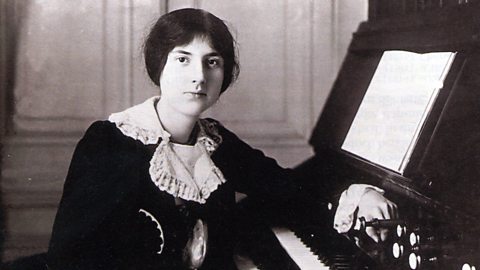Dates: b. 1893 / d. 1918
Nationality: French
Date of composition: 1917 - 18
Period: 20th Century
Genre: Impressionist
Key musical elements:
- Dynamics / texture

About Lili Boulanger
- Lili Boulanger's musical talents spotted before she could speak.
- As a child she learnt lots of instruments, including piano, violin, harp, cello and she also loved to sing.
- Aged 19, Lili entered the famous ‘Prix de Rome’ competition and became the first woman to ever win the competition.
- Lili’s sister, Nadia Boulanger, supported Lili when she composed music. Nadia was a talented musician herself and wanted to help her sister realise her musical aspirations despite her struggle with illness.
- Although Lili had a tragically short life, her music is sophisticated, energetic and exciting for both players and listeners.
About the piece
- Lili Boulanger's musical energy and youthful passion can be heard in D’un matin de printemps, which translates as ‘Of a Spring morning’.
- This piece is an example of ‘Impressionist’ music, which focusses on the mood and emotion in music. The Impressionist style was particularly popular amongst French musicians, including Debussy. It is also a style of painting made famous by artists such as Monet and Renoir.
- Boulanger captures the colours of spring in her music making some parts full of shadows and others full of light.
Listen out for
- The melody in the flute at the beginning and how it is played by different instruments throughout the piece.
- Busy musical lines for every instrument, creating an interesting musical texture.
- The different dynamics that add colour to the music. Some parts are strong, bright and alert whilst others are softer, more dreamlike and mysterious.
- Towards the end the music builds in dynamics to a sparking finish.
Watch the films
Naomi Wilkinson explores the busy, hopeful soundscape of spring created by the rhythms and dynamics of Lili Boulanger's D'un matin de printemps
Naomi:
What do you notice when the seasons change? Different colours? A change in the weather?
What about the sounds that you can hear?
The leaves in the trees sound different when they're fresh in the spring, rather than when they're dry and crispy in autumn, or in winter when there aren't any leaves at all.
Each season has its own soundscape, and none is busier and more hopeful than the spring.
When you're out and about in springtime you can hear bees buzzing and birds singing. It's all going on. And it was the busyness and joy of springtime that inspired French composer Marie Juliet Olga Boulanger, known to her friends -that's us- as Lili, to write her piece D’un matin de printemps. That's French for ‘On a Spring Morning’.
Lili Boulanger is using the instruments to create the sounds and feeling of a busy spring morning out in the garden or in the park. The string instruments are playing a fast repeated rhythm, over and over. It's called an ostinato. Almost feels like the hum or buzz of bees, busy and constant.
The melody played by the flute at the beginning is copied by different instruments as it echoes through the orchestra.
It's a bit like birds singing or calling to one another.
Lili Boulanger was born in Paris in 1893, and even from a really young age, she loved playing music, and she was a very talented composer.
D’un matin de printemps - On a Spring Morning - was written as part of a pair of pieces. The other half of the pair was D’un soir triste, which means On a Sad Evening. That's quite a different vibe from a spring morning, isn't it?
I wonder why Lili wrote these two pieces to go together. This young woman was feeling inspired by the hope of spring, so she was feeling hopeful. But she was also very ill, and sadly, she died when she was just 24 years old. By writing both pieces, Lili Boulanger is showing the world that she was feeling several emotions all at once.
Oh, now what kind of bird is that? I have a trusty book of bird facts here to help me. It’s like a handy set of instructions for nature. And luckily many composers give instructions too, on how their pieces should be played. It means the musicians are able to play the piece as the composer intended.
At the beginning of On a Spring Morning, Lili Boulanger asks that the notes be played, in French, léger and gai, which means light and cheerful. After a happy and energetic start to the music, the mood changes. Here, the instruction from the composer is to play mystérieux, or mysteriously, with slower, longer notes.
I wonder what could be happening out in the garden during this change?
The clouds are rolling in. The music builds and builds and listen, here comes the rain.
But don't give up and head inside just yet. No, a violin solo plays the spring melody from the beginning of the piece.
The rain is stopping. Sun is peeking through the clouds. Typical spring weather!
Gwyliwch D’un matin de printemps yn cael i berfformio gan y Cerddorfa Cyngerdd y BBC, a’u harwain gan Ellie Slorach
Classroom resources
Lesson plan (KS2/2nd level/Progression Step 3)
Download the lesson plan for four weeks of learning and activities for D'un matin de printemps (PDF)

Powerpoint slides (KS2/2nd Level/Progression Step 3)
Download the Powerpoint slides for four weeks of learning and activities for D’un matin de printemps (PPT)

Listen to the audio
Listen to the BBC Concert Orchestra performance of D'un matin de printemps (mp3)

KS3 / Third and Fourth Level, S1-3 Independent Lesson Worksheet
Download this worksheet for secondary level cover lesson activity to be completed alongside the intro and performance films - D'un matin de printemps (PDF)

Upload and showcase your creative responses
Upload your creative responses to the BBC Ten Pieces Showcase

Arrangements
The arrangements of D'un matin de printemps by Fiona Brice are for Grade 3 and above players. The different levels are interchangeable.
Explore the seasons
KS1 / KS2 Geography: The seasons
This animated video explores the four seasons and how they change.

The changing seasons
A look at what happens to different landscapes through the four seasons.
